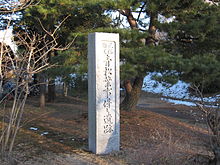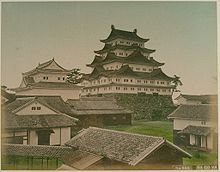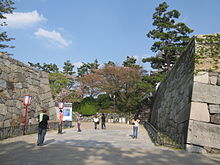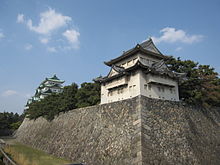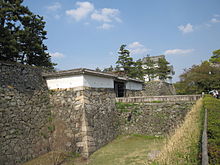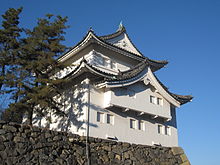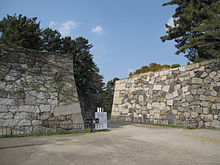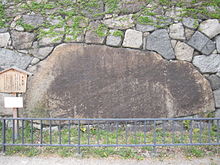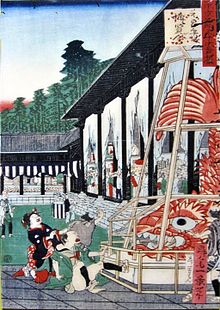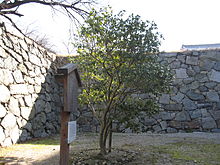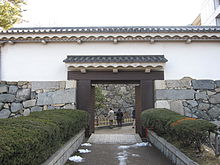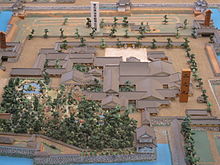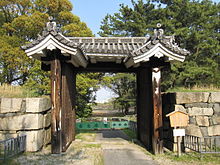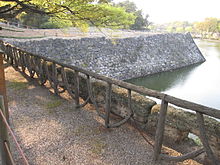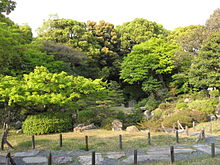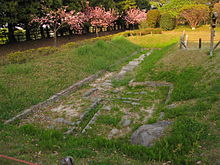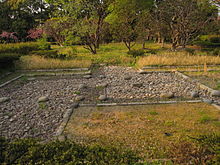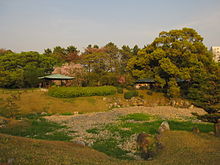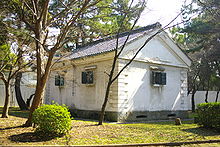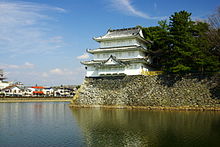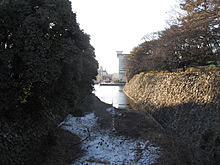- Nagoya Castle
-
For Nagoya Castle in Hizen Province, see Nagoya Castle (Hizen Province).
Nagoya Castle
名古屋城Nagoya, Japan 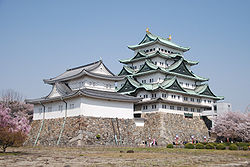
The two main keeps of Nagoya CastleType Flatland Construction
materialsGranite stone, earthwork, wood Occupants Owari branch Nagoya Castle (名古屋城 Nagoya-jō) is a Japanese castle located in Nagoya, central Japan. During the Edo period, Nagoya Castle was the center of one of the most important castle towns in Japan—Nagoya-juku— and it included the most important stops along the Minoji, which linked the Tōkaidō with the Nakasendō.[citation needed]
Contents
History
In order to advance into Owari, Suruga Province military governor Imagawa Ujichika built Yanagi-no-maru during the Taiei era from 1521-1528 for his son Imagawa Ujitoyo. It was the original castle at Nagoya, located around where the later Ninomaru residence of the castle would be. Oda Nobuhide seized it from Imagawa Ujitoyo in March 1532 (Kyōroku 5) and moved in and called it Nagoya Castle.
Oda Nobunaga was supposedly born here 1534 (Tembun 3), although this is subject to debate. After he defeated Oda Nobutomo at Kiyosu Castle in April 1555 (Kōji 1), he established his residence there. Around 1582 (Tenshō 4), the castle at Nagoya was abandoned.
After the various upheavals in Japan, Tokugawa Ieyasu emerged victorious. He decided in November 1609 (Keichō 14) to rebuild the castle at Nagoya. Up until the Meiji Restoration, Nagoya Castle would flourish as the castle where the Owari branch, the foremost of the three Tokugawa clan lineages, resided.
The technology of the construction had been extensively developed and consolidated since the construction of Azuchi Castle in 1576 by Oda Nobunaga (1534-1582). One of the main architects who designed and directed the building of the castle was Nakai Masakiyo, who was previously involved in the construction of the Nijo, Fushimi, Edo and Sunpu castles. He had gathered and refined existing castle and fortification construction technology and techniques and ultimately formulated the standards for the Tokugawa Shogunate's castles as exemplified by Nagoya Castle.
In January 1610 (Keicho 15), the construction site was roped off and work began. Tokugawa Ieyasu ordered the various daimyo to help with the building of a new castle on the site. This new castle was to become the new capital of the existing Owari Province. Kato Kiyomasa, Fukushima Masanori, and Maeda Toshimitsu were some of the 20 feudal lords from the northern and western part of Japan who were appointed to the construction. The inscriptions of feudal lords and their vassals carved on the stones they carried still visible today on the stone walls. In August 1610 the stone foundation of the main donjon (tenshu) was completed, in December the construction of the stone walls for the Honmaru, Ninomaru, Nishinomaru and Ofukemaru was almost completed.
In June 1611 (Keicho 16), the construction of a canal, which today is the Hori River, was completed. The source for many of the building materials for the new castle was from the smaller Kiyosu Castle, including Kiyosu castle's tenshu, which was rebuilt as the northwest turret. In mid-1612 (Keicho 17), the construction of the Honmaru Palace began and the main donjon was completed in December of that year.
The artist Kano Sadanobu and other painted the walls, ceilings and sliding doors of the Honmaru Palace in 1614 (Keicho 19). Construction of the gates and the Sannomaru moat were completed in July, and in November of that year the Shogun Tokugawa Hidetada came for an inspection of the castle. The Honmaru Palace was completed in February 1615 (Keicho 20).
The Ninomaru Palace was completed in 1617 (Genna 3). Toshogu was established in the Sannomaru in 1619 (Genna 6) and the northwest turret, the former Kiyosu Tower, of the Ofukemaru completed. In 1620 (Genna 6), Tokugawa Yoshinao moved into Ninomaru Palace. In 1627 (Kan'ei 4), a sanctuary was constructed in the Ninomaru.
Overall renovation began on the Honmaru Palace in May 1633 (Kan'ei 10) for use a lodging for the upcoming visit of the Shogun Tokugawa Iemitsu on his way to the imperial capital Kyoto. Additional chambers, bathrooms and halls such as Jorakuden and Oyudonoshoin were constructed. Kano Tanyu and others painted the walls, ceilings and sliding doors in the new extensions in 1634 (Kan'ei 11), and work was completed in June, just in time for the shogun's visit in July of that year.
For the next almost 100 years, most of the work would be maintenance and renovation of the existing structures. In 1669 (Kambun 9), repairs were made to the main donjon walls and roofs. In November 1685 (Jōkyō 2), repairs were made to the main donjon roof, in March 1709 (Hōei 6) to the first and second stories of the main donjon, in August 1720 (Kyōhō 5) to the chidorihafu gables on the third and fourth levels of the main donjon and in December 1726 (Kyoho 11) to the third-level roofs karahafu gables and of the fourth-level roofs and copper tiles of the fifth-level roofs of the main donjon. Repairs were also made to the golden dolphins of the main donjon, replacing the wooden core. Further work was carried out in August 1728 (Kyoho 13) on the shingled roof of the Honmaru Palace, remodeling it into the lightweight, informal roof. Repairs were made to the second, third- and fourth-level roofs of the main donjon.
In November 1730 (Kyoho 15), the golden dolphins were recast for the first time and covered in wire mesh.
In 1752 (Hōreki 2), the large-scale "Restoration of Hōreki" corrected the tilt of the donjon, due to unequal subsidence of its stone wall, and the roofs from the second level up were tiled with copper.
By 1788 (Tenmei 8), the debt of the Owari branch since 1767 (Meiwa 4) reached a value of 215,000 ryo. As a result, the golden dolphins had to be molten and recast with less gold in 1827 (Bunsei 10). A finer wire mesh covered the dolphins to hide the fact that they were less golden. In 1846 (Kōka 3), they were molten again and recast for the third time.
As the Tokugawa Shogunate was coming to an end, law and order started breaking down. The Aomatsuba Incident took place on January 1868 (Keio 4) in the Ninomaru Palace. A stone memorial was later set up in the 1920's.
After the end of the Shogunate, the Owari branch decided to submit themselves to the emperor. In 1870 (Meiji 3), Tokugawa Yoshikatsu decided to demolish the castle and donated the golden dolphins to the Imperial Household Department. The dolphins were taken down from the main donjon in April 1871 (Meiji 4) and transported by steamship from Atsuta Port to Tokyo. The dolphins would travel around Japan on exhibitions and the female one even to 1873 Vienna World Exposition for the next couple of years, until they were returned to the castle in 1873.
In May 1872 the 3rd Division of the Tokyo Garrison was stationed at the castle and the Nagoya Detached Garrison and barracks were installed on the castle grounds. The plan to demolish the castle were put on hold after the German minister to Japan, Max von Brandt, spoke out against it. In December 1879 (Meiji 12), the imperial war minister Yamagata Aritomo decided to put the castle under preservation on the advice of Colonel Nakamura Shigeto.
The Great Nobi Earthquake on October 1891 (Meiji 24) seriously damaged the southwest and Tamon turrets and other structures. Reconstruction and repair work followed. In 1893 (Meiji 26), the castle was transferred to the Imperial Household Ministry and in June the name of the castle was changed to Nagoya Detached Palace or Nagoya Imperial Villa as a formal imperial residence.
On May 20, 1906 (Meiji 39), the ground were specially opened to the public for one day for the National Railroad Five Thousand Miles Celebration. In March 1910 (Meiji 43), bronze dolphins brought from Edo Castle were added to the roofs of the small donjon and corner turrets. On February 1911 (Meiji 44), the former Hasuike Gate of Edo Castle war transported and reconstructed on the remains of the Nishinomaru-Enoki Gate, which today is used as the main gate for visitors. In 1923 (Taishō 12), the southwest turret was repaired.
On December 11, 1930 (Shōwa 5), the ownership of the castle was transferred from the Imperial Household Ministry to the City of Nagoya, thus abolishing its status as an imperial villa. In the same month, 24 structures on the castle grounds were designated as national treasures, under the old national treasure system. On February 11, 1931 (Shōwa 6), the grounds were opened to the general public. The next decade saw conservatory and archaeological activities, as the castle was scientifically documented. In May 1932 (Shōwa 7), a field survey and measurement of the castle were conducted. In July of that year, the old Kayanoki (Japanese nutmeg) tree in the Nishinomaru was designated as a national monument. In December the castle was designated a historical site. In 1936 (Shōwa 11), the Sarumen Tea House in the Ninomaru was designated as a national treasure. In June 1942 (Shōwa 17), some of the Honmaru Palace paintings were designated as national treasures. Most of the sliding doors and paintings were put into storage as World War II started reaching the Japanese mainland.
During World War II, the castle was used as the Tokai district army headquarters and the main POW camp in Nagoya, although it held no prisoners and was just the administration office.[1] The aerial bombardments by the United States Air Force brought the most destruction to the castle in its entire history. On January 1945 (Shōwa 20), the Sarumen Tea House was destroyed in air raids. On May 14, the main donjon, small donjon, golden dolphins, Honmaru Palace, northeast turret and other buildings were completely destroyed in air raids. In June of that year, some of the paintings saved from the Honmaru Palace were moved for safekeeping to the Haiho Shrine, Toyotashi. These returned from the shrine in May 1946 (Shōwa 21).
The castle's surviving former national treasures, which included the southwest, southeast, northwest turrets, the Omoto-Ninomon Gate and some the Honmaru Palace paintings were redesignated as important cultural assets by the national government. In 1953, the southeast turret was dismantled for repairs. The Ninomaru Garden was designated as a place of scenic beauty.
In June 1955 (Shōwa 30), most of the Honmaru Palace paintings, and a exactly year later the ceiling panel paintings were designated as national important culture assets.
In 1957 (Shōwa 32), reconstruction of the castle donjons were started. The second-generation golden dolphins were cast in the Osaka Mint and transported to the castle. On October 3, 1959 was the reconstruction of the two donjons completed and opened to the public. The next couple of decades saw further renovation work. In March 1964 (Shōwa 39), the northwest turret was dismantled for repairs. In 1967 (Shōwa 42), the Ninomon of the western iron gate was dismantled for repairs. In 1972 (Shōwa 47), the stone walls at the west side of the East Iron Gate of the Ninomaru were dismantled. The wooden Ninomon was dismantled and later rebuilt at the east Ninomon Gate of the Honmaru.
In preparation for the Expo 2005, plaques using the English language were added to most displays for the castle and a 3-D movie showing the paintings in Honmaru Palace (本丸御殿 Honmaru Goten) was created for the anticipated large number of visitors to view. Reconstruction work of the destroyed Honmaru Palace begann in 2009 and is slated for completion by 2017.
Layout
The castle complex is made up of several enceintes, which are divided by the outer moat (Soto-bori) and inner moat (Uchi-bori). Each enceinte is protected by walls and turrets that were strategically located at each corner. Access from one enceinte to the next was controlled by guarded gates that were accessible by bridges. The castle is a good example of the type built on flat lands.
Seen from above, the Honmaru enceinte is in the centre of the complex, containing the main and minor donjon, along with the palace. The Ninomaru enceinte is located to the east, the Nishinomaru to the west, the Ofukemaru, also known as the Fukaimaru, to the northwest, and the Sannomaru around the east and south. Today's Meijō Park was part of the larger castle's grounds to the north, which were used as pleasure gardens with a large pond.
The larger Sannomaru used to be buffered by two moats and encircled the inner castle enceintes from the east and the south. Various temples and villas, as well as administrative buildings used to be located in its area. On the eastern side, the large stone foundations of the Sannomaru East Gate are still visible. None of the original wooden structures of the Sannomaru have survived, but the area is still the administrative center of the city of Nagoya and the surrounding Aichi Prefecture, with Nagoya City Hall, the Aichi Prefectural Government Office and other administrative buildings and offices being located in this area. Roads and areas such as Sotobori-dori (Outer Moat Road) and Marunouchi have their origins from the castle.
Nishinomaru
Nishinomaru-enokida Gate
This gate was originally called the Nishinomaru-enokida Gate and is used today as the main gate to Nagoya Castle. It was destroyed by fire during World War II. The gate was reconstructed together with the donjon in 1959.[2]
Torreya Nut Tree
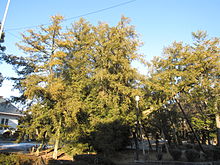 The old Torreya Nut Tree stood even before the castle
The old Torreya Nut Tree stood even before the castle
An old Torreya Nut Tree (Torreya nucifera) is located close to the Nishinomaru-enokida Gate to the north. Its height is 16 metres and eight metres at the base. It is over 600 years old and was already there when the castle was constructed. This is the only government-designated natural monument in Nagoya. Damaged by the air raids of 1945, the tree fortunately regained its viability. Tokugawa Yoshinao, the first lord of the castle, is said to have decorated his dinner tray with torreya nuts from this tree before going into battle in Osaka, and later for New Year's celebrations.[2]
First Front Gate
Destroyed in World War II, the First Front Gate formed a square shape with the Second Front Gate, and had a smaller gate on the side with a gabled and tiled roof. The wall section under the front part of the gate was covered in wooden tiles, and the gate itself was iron plated and rocks could be dropped from a second-storey machination. The door on the smaller gate was latticed for reinforcement.
Ote Umadashi
The Ote Umadashi was once a small defensive wall in front of the Second Front Gate. This wall was located on the front side of the castle wall. A moat once served for protection between this point and the Nishinomaru, but it was filled in when the area was turned into an imperial detached palace from 1893 to 1930, because it disrupted the flow of carriage traffic.
Honmaru
Southwest Turret
The southwest turret is also called the Hitsuji-saru (sheep-monkey) turret, because these two animals denoted the southwest compass direction in the Chinese zodiac. It is three stories tall with a two-level roof. On the west and south sides, trap doors project below the lower-level roof, which were designed for dropping stones on attacker to defend the castle. The symbol of the chrysanthemum, the Imperial Crest, can be seen on the ridge-end tiles.[2]
This tower and the stone wall were destroyed during the great Nobi Earthquake in 1891 and later rebuilt in 1923 under orders of the Imperial Household Ministry. It is designated an Important Cultural Asset.
Second Front Gate
The Second Front Gate (Omote-ninomon) was formerly called the Second South Gate (Minami-ninomon) and leads into the inner Honmaru enceinte. The gate has heavy timber columns and a crossbar which were covered with strong iron plates and especially thick. On either side of the gate are rare examples of fireproofed plaster walls. Since the gate is still an original, it has been designated an Important Cultural Asset.[2]
Southeast Turret
Called the "Tatsumi" turret, the southeast turret looks like it has two stories, but actually has three. The white coating on the mud walls made the structure water- and fireproof. The southeast turret is similar to the southwest turret. The construction adheres to the original design by the Tokugawa. The symbol of a hollyhock, the crest of the Tokugawa family, can be seen on the ridge-end tiles. The turret has been designated an Important Cultural Asset.[2]
First East Gate
The First East Gate was a sturdy gate that forms a square shape with the outer gate. It also had a gabled, tile-roof, along with a smaller gate on the right hand side that connects with the tower gate. This gate was similar to the First Gate that was destroyed during World War II.
Kiyomasa Stone
Many of the gates of Nagoya Castle have a square layout and the stone walls include several large stones to demonstrate the castle's defenses. According to legend, Kato Kiyomasa, a renowned general and castle engineer at the time, hauled a large stone to the castle that was later named after him.[2] But it is probable that this part of the castle's foundation was constructed by Kuroda Nagamasa. Feudal lords who were ordered to build the stone walls carved their marks on the stones in order to distinguish their own from stones of other lords.
Keeps
Nagoya Castle is known for its unique "connected-donjon" style of construction with the main donjon of five stories on five different levels and a smaller donjon of stories, two levels, joined by an abutment bridge. Evidence that another small donjon was planned for the west side of the main donjon can be found in traces of an entryway in the upper part of the stone wall foundation on that side. The entryway to the small donjon was also planned for the west side. However during the construction, the location was changed to where it is today. Traces of the original entryway remain inside the stone wall.
Various types of weapons were also stored on the first level of the castle's main donjon. Later, to prevent disasters due to accidents, flammable materials such as gunpowder were moved and kept in facilities outside the castle.
The small and main donjon both burned down during World War II and were reconstructed in 1959.[2]
The job of constructing the castle walls was divided among twenty feudal lords, including Kiyomasa Kato. The walls of the donjon were built by the Kiyomasa family and the cornerstones of the building bear the inscriptions of the family members in charge of the construction. Those of Kato and retainers can be seen on the northeast corner. In the stone walls of the castle, there are marks of figures of triangles in circles, and the rough outlines of folding fans, war fans, and other objects. These are called kokumon or carved crests, and represent the different daimyo lords and their vassals who were apportioned sections in the construction. The signs were carved into the stone so that there would be no mistake as to which lord contributed which stone in the transportation, and to avoid disputes. Some of the foundation stones of the main castle tower were moved to a lawn on the north side during the 1959 reconstruction, due to damage from the immense heat of the fire and subsequent collapse of the tower.
The stone wall supporting the donjon was constructed by the technique called ogi kobai or "fan sloping", by which the upper part of the wall is curved outward like a fan. This wall is also called the Kiyomasa-style Crescent Stone Wall, after the general and engineer Kiyomasa Kato, who was in charge of its construction. The fan sloping technique was used to prevent swelling by curving the middle portion of the wall inward, thereby evenly balancing the stone weight against the pressure of sand and earth within.
There is a roofless corridor between the main and the small donjon. The walls in this corridor were earthen and stone, and mounted on the outer part of the west side are numerous 30 centimetre-long spearheads.[2] These spearheads would thwart enemy climbers from coming over the eaves. This sword-fence can also be found at the Fumei Gate, facing the east side of the main donjon.
Golden dolphins
On either end of the topmost castle roof are two golden tiger-headed dolphins, called kinshachi (金鯱). This motif was used as a talisman to prevent fires. They first appeared in the Muromachi era (1334-1400) as a symbol of the lord's authority.
The original golden dolphins were formed over a roughly carved block of wood over which lead sheets were applied. Copper was placed over the lead, before the application of the final layer of gold which was produced from pounding gold coins into thin sheets. It is said that the gold used amounted to a value of 17,975 ryo (taels), when converted from Keicho-period coins. The core of the golden dolphins are composed of hinoki cypress, originally the foundation was sawara cypress.
The golden dolphins were melted down and recast three times during the Edo period, when the Owari branch suffered severe economic hardship. When the dolphins were recast in Bunsei 10 (1827), the purity of the gold was greatly decreased. In order to conceal the diminished luster, openings in the mesh in the protective bird screens built around the dolphins were made smaller during the Kyoho period (1715-1735).
After the Meiji Restoration, there was a trend to abandon old ways and plans were made to dismantle the castle donjons. During this time, the golden dolphins were donated by the Owari branch to the imperial government. In Meiji 4 (1871), they were removed from the main donjon and transported to Tokyo from Atsuta Port. When a scaffold was erected, a sentry from the army division stationed at the castle stole some scales.
In March 1872 (Meiji 5), the male dolphin was exhibited at Japan's first exposition in Yushima. Later, the male was displayed at regional expositions held in Ishikawa, Oita, Ehime and Nagoya. The female dolphin was even exhibited at the World Exposition in Vienna in 1873. Later, when it was decided to preserve the donjon, a movement to return the dolphins was initiated. In Meiji 11 (1878), the golden dolphins were returned to Nagoya and restored to their original position in February of the following year.
Later in Meiji 9 (1937), during an inspection by the Castle Imperial Grant Commemorative Committee, a thief climbed the scaffold and stole scales. He was later caught in Osaka. Responsibility for this incident was traced back to city executives. Since the Meiji era, the golden dolphins have suffered theft on these three instances.
The dolphins were destroyed by fire during World War II. The second-generation golden dolphins were cast in the Osaka Mint and transported to the castle in March 1959 (Showa 39). Both kinshachi were lowered temporarily from atop the castle and displayed on the castle grounds briefly in September 1984 (Showa 59) for the Nagoya Castle Exhibition, and again from March 19 to June 19, 2005 (Heisei 17) at the site of the Expo 2005. They were restored to the top beam of the castle roof on July 9, 2005 of the same year.
The kinshachi are male and female, with different specifications. The northern kinshachi is male, has a height of 2.621 Metres, weighs 1,272 kg, its number of scales is 112 and the weight of the gold (18 K) is 44.69 kg. The southern kinshachi is female, has a height of 2.579 metres, weighs 1,215 kg, its number of scales is 126 and the weight of its gold is 43.39 kg. For both dolphins, the gold plate quality is 18K and 0.15 mm thick.
Camellia Tree
There was once a camellia tree somewhere in the garden south of the Honmaru Palace. Since the Edo period this tree was considered to be a secret treasure of the Owari domain and every spring, it would bloom with large, colourful white flowers. The original tree was thought to have been lost when the castle burned down during an air raid in 1945, but remarkably new buds started to grow from the charred stump. The current tree was grafted from the original in 1955 and continues to grow today.
Fumei Gate
The Fumei Gate (Fumei-mon) is located in the Tamon Wall, which leads into the Honmaru. It was always locked securely and therefore known as "the gate that never opens". The wall is called a "sword wall", because spearheads under the eaves prevented penetration by spies or attackers. The gate was destroyed in the air raid on May 14, 1945. It was reconstructed to its original form in March 1978.
Ninomaru
The Ninomaru Palace is thought to have been completed in 1617. Tokugawa Yoshinao, the first feudal lord of Owari, moved to this palace from Honmaru Palace in 1620. Besides serving as the residence of the lord, the palace functioned as the administrative center of the feudal government. Many more palaces were built in later years.
The Tokugawa Museum has a partial reconstruction of the reception chambers, such as the Kusari-no-ma and the Hiro-ma, which include display alcoves, staggered shelves and writing alcoves equipped with authentic furnishings.
The palace had two stages for performances of Noh: the omote-butai, or front stage, and oku-butai, the rear stage. Noh was performed to commemorate a lord's succession to a fiefdom and to celebrate the birth of an heir. The Tokugawas of Owari were patrons of many Noh actors. The modern Nagoya Noh Theatre was opened in April 1997 and is situated just south of the front gate of Nagoya Castle. A reconstruction of one of the Noh stages of the Ninomaru can be seen in the Tokugawa Art Museum. The tradition of courtly Noh is upheld in the Nagoya Noh Theatre, located in the Sannomaru enceinte.
The Ninonomaru last existed in the Kaei period (1848-54). Facilities for conducting clan affairs, residences for retainers, gardens and stables (Mukaiyashiki) were located there. The western two-thirds of the area was known as the Oshiro (the castle), while the eastern one-third was called Ninomaru Goten (the palace). The gardens originally included flowering trees, stone lanterns and a traditional Japanese-style tea arbour arranged in a circular pattern. After the Meiji Restoration, the original was demolished to build army barracks, but it was restored and designated as an official scenic spot after the war.
Three chief retainers of the Owari branch were executed in the Ninomaru Palace in 1868 what became known as the Aomatsuba Incident. Early in the Showa era, around 1926, a monument was erected at the execution site. The exact site is unknown although it is thought to have taken place approximately 100 metres south of the current site of the monument. The stone stelae was re-erected after the original one disappeared.
Old Ninomaru Second East Gate
The old Ninomaru Second East Gate, also called the East Iron Gate, was the outer gate of the Ninomaru enceinte on the east side. It was a square, box-like structure with two separate doors opening into and out of the enclosure. In 1963, the gate was dismantled and stored temporarily to make way for the construction of the Aichi Prefectural Gymnasium. In 1972, the gate was relocated to the side of the old Honmaru East Gate, where it stands today. The gate, built in the style of gates in ancient Korea, with a tile-covered slanting roof and plastered eaves, has iron-banded pillars, a crosspiece and doors.
Uzumi Gate
The Uzumi Gate led to an underground tunnel that ran beneath the castle walls. This tunnel was the secret escape route to the be used by the lord of the castle during times of emergency. The remains of the entrance can be found in the northwest part of the Ninomaru Garden. Steep stairs led down to the moat. The lord could cross the moat by boat to reach the Ofukemaru Garden on the opposite side. He could use a secret escape route to get to the Kiso Road by way of Doishita, Kachigawa and Jokoji Temple.
Namban Wall
The remains of the Namban, or European, wall can be seen north of the Ninomaru Garden where they run from east to west on top of the stone wall. This sturdy wall was constructed using the European plaster method, topped with tiles, and had many round gunports. Today this wall is considered to be a unique feature to Nagoya Castle and has been designed an important cultural asset.
Ninomaru Garden
Ninomaru Garden and what is presently known as Ninomaru East Garden were once part of the Ninomaru Palace. It is said to have been built between 1615 and 1623, when the Ninomaru Palace was constructed. The sanctuary on the north side of the palace was its centrepiece. It was however transformed into a Japanese dry landscape garden in 1716, designed to be walked through.[2] The garden has been remodeled many times since then, especially between 1818 to 1829/1830. Although the area of the garden is small, it was designed to represent steep hills, forests, and deep valleys. There were also many large rocks placed within its boundaries. On top of the hill the thickly growing trees offered the lord protection from enemies by providing a hiding place and a secret escape route. These characteristics of the garden have faded over the years, but the basic structure of the original plan still remains. The garden has been expanded and undergone restorations during the years.
This dry landscape garden covers an area of 5,137 square metres (55,290 sq ft) and is separated into north and south areas. Comparatively, the north half of the garden retains more of the shape of the original garden. The pond is surrounded by five artificial mountains and has several islands. There are various kinds of walkways around the garden, including a stone bridge, mountain pathway, and shoreline path. The pond represents a ravine made up with many round rocks.
The garden has many high quality rocks from various regions throughout Japan and some of them, including the pines, can be used for medicinal uses. Located in the garden is a modern teahouse, constructed out of hinoki cypress from the Kiso region. A tatami mat room and a washing room are located in it.[2]
Ninomaru East Garden
According to the Oshiro Oniwa Ezu, the Ninomaru Palace Garden was grand in scale, featuring Mt. Gongen in the north, Mt. Sazae in the west, a large pond in the south, and six tea houses dotted around the rest of the garden.
During the early years of the Meiji era, an army barracks was set up in the eastern garden. Mt. Gongen was leveled and the pond filled in to make room for the military barracks. In 1975, part of the garden was excavated, using the old drawing as a guide. The garden was renovated mainly around four unearthed structures: the North and South Ponds, the site of the Soketsu-tei teahouse and the so-called North Culvert. The garden was opened to the public in April 1978 and named the Ninomaru East Garden. Rebuilt, the four form the main features of the 14,000 square metres (150,000 sq ft) garden. Also nearby are gardens of peonies and other flowers.[2]
North Culvert
The remains of a drain located outside the garden depicted in Oshiro Oniwa Ezu, a historic drawing of the old castle garden, have been restored exactly as they were found in an excavation survey. According to the drawing, there was also a flower bed nearby this drain, which is thought to the remains of a stone culvert for channeling rainwater, as mentioned in the "Kinjo Onkoroku" document. Even today rainwater is channeled to the moat through this drain. The stone materials of the culvert include granite for the lid and hard sandstone for the sides.
Site of the Soketsu-tei
Six tea houses used to be located in the old Ninomaru Garden, including Tashun-en, Yamashita Oseki, Yoho-tei and Fushin-tei. A reconstruction of the thatched Sarumen tea house is located in the Tokugawa Museum. The Soketsu-tei, the largest one of them, was built in the Sukiya style. In an excavation survey, a site almost exactly matching that of the Soketsu-tei as depicted in Oniwa Ezu, the historic plan of the old castle garden, was identified. Today, cobble stones are placed to mark where tatami mats would have been, rubble and plaster where the hallway was, and gravel on the other surfaces for an easy understanding of the original structure.
South Pond
In the historic drawing of the old castle garden, the Oshiro Oniwa Ezu, a dry pond is depicted with a large boat-shaped stone on the northern shore and an island of rocks in the middle. In an excavation survey, the large boat-shaped stone was not found, but it is believed that the island lies under three rocks in the pond which can be seen. The actual pond is believe to have been deep, surrounded by sturdily piled rocks, and exceptionally large in scale, much larger than depicted in the drawing.
Ofukemaru
Formally a marsh located on the northern edge of the Nagoya Plateau, the Ofukemaru is said to have been reclaimed with pine and many other trees at the time of the castle's construction. It is also known as the Fukaimaru.
Necessary arms and ammunition, etc. outside that which the retainers had in their own possession, were originally stored in the facilities called Ozutsu-gure, Tezutsu-gura, Migaki-gura and Ana-gura, as well as Shio-gura (salt storehouse) in the eastern corner. The warehouses have almost all disappeared over time, some teahouses are now there instead.
Nogi Warehouse
After the deployment of a garrison of the Imperial Army in 1872, was the whole Sannomaru enceinte of the castle placed under their control in 1874. The warehouse was probably constructed in 1880 (Meiji 13) as an ammunition depot for the army.[2] It was named after General Nogi Maresuke, who was posted to Nagoya during the early Meiji era (1868-1912). It is the only warehouse that has survived in the Ofukemaru.
This warehouse is a one-story brick building with white plastered walls, small windows on the side and a Japanese-styled tiled roof. Its total size is 89.25 square metres, 12.28 metres from east to west, 8.6 metres from north to south, and 7.68 metres in height. The size of the ancillary gunpowder depot is 13.12 square metres. The building is characterised by the arched entrance and the underfloor area, as well as the white-coloured masonry plaster at the corners of the building. The doors are covered with copper sheets, as well as the four small windows on the sides.[2]
Although the castle itself was destroyed during World War II, the screen and ceiling paintings of the Honmaru Palace were left undamaged because they were being stored in this warehouse.[2]
Northwest Turret
Also called Inui turret, the northwest turret is three-storey structure with a roof at each level. The top layer, designed in the irimoya style, is covered with tiles. Many materials were taken from previous structures in Kiyosu Castle constructing this tower, it is therefore also called the Kiyosu turret.[3] It is designated an Important Cultural Asset.[2]
Projections on the first-storey outer walls facing north and west are trapdoors from which stones could be dropped on attacking forces. They are disguised with gabled roofs. Unlike other corner turrets that still exist, the northwest turret has gables on the east and south facing inside, projecting an image of balance and stability.
"Cormorant's Neck" Moat
In places such as the Ofukemaru and Nishinomaru the moat comes in close to the castle wall. This is called the cormorant's neck because it is long and thin. This was done to increase the defendability of the castle. Five of these cormorant-neck shaped moats still exist throughout the castle area.
Plants and animals
The Ninomaru gardens and other areas such as the Ofukemaru have a wide variety of flora. In Spring, Japanese Cherry, wisteria, camellia and peony bloom. In the summer it is iris, crape myrtle, plantain lily and hydrangea, in autumn the confederate rose, Japanese quince and crape myrtle, and in winter the Japanese witch hazel, Japanese quince, wintersweet and Japanese plum[disambiguation needed
 ] that bloom.[4] During the summer, Sika Deer can also be observed grazing in the moats that are dry and covered with grass.[5] Various birds such as ducks and songbirds also inhabit the castle grounds as their sanctuary in the middle of the city.
] that bloom.[4] During the summer, Sika Deer can also be observed grazing in the moats that are dry and covered with grass.[5] Various birds such as ducks and songbirds also inhabit the castle grounds as their sanctuary in the middle of the city.Cultural influence
Another way of pronouncing Nagoya Castle (名古屋城) is Meijō (名城). This name can be found for many things in the city, such as the Meijō Park, the Meijō Line and Meijo University.
Nagoya castle has been featured in many films such as Mothra vs. Godzilla and Gamera vs. Gyaos.
See also
- Ōzone Shimoyashiki, a residence established by Tokugawa Mitsumoto (1625-1700), second lord of Owari
- List of Special Places of Scenic Beauty, Special Historic Sites and Special Natural Monuments
References
- ^ "POW Camps in Japan Proper". Archived from the original on 2007-03-16. http://web.archive.org/web/20070316125931/http://homepage3.nifty.com/pow-j/e/POW+Camps+in+Japan.doc. Retrieved 2007-09-04.
- ^ a b c d e f g h i j k l m n o "Nagoya Castle Map". Nagoya Castle Official Website. January 2011. http://www.nagoyajo.city.nagoya.jp/13_english/13_03_guide/index.html. Retrieved 5 March 2011.
- ^ "Kiyosu Castle". Kiyosu City. 2010. http://www.city.kiyosu.aichi.jp/en/sightseeing01.html. Retrieved 5 March 2011.
- ^ "Flowers and Blossoms". Nagoya Castle Official Website. 2010. http://www.nagoyajo.city.nagoya.jp/13_english/13_04_shiki/index.html. Retrieved 5 March 2011.
- ^ "Image". Wikimedia Commons. 13 April 2009. http://commons.wikimedia.org/wiki/File:Nagoya_Castle_2009_6.jpg. Retrieved 5 March 2011.
Literature
- Schmorleitz, Morton S. (1974). Castles in Japan. Tokyo: Charles E. Tuttle Co.. pp. 128–142. ISBN 0-8084-1102-4.
- Motoo, Hinago (1986). Japanese Castles. Tokyo: Kodansha. pp. 200 pages. ISBN 0-87011-766-1.
External links
- Official Homepage
- Hommaru Palace Website of reconstruction efforts with 3D images
- History of Nagoya Castle
- Nagoya Castle (moving image)
Coordinates: 35°11′08″N 136°53′55″E / 35.18556°N 136.89861°E
Categories:- Houses completed in 1612
- Castles in Nagoya
- Museums in Nagoya
- Special Historic Sites
Wikimedia Foundation. 2010.


